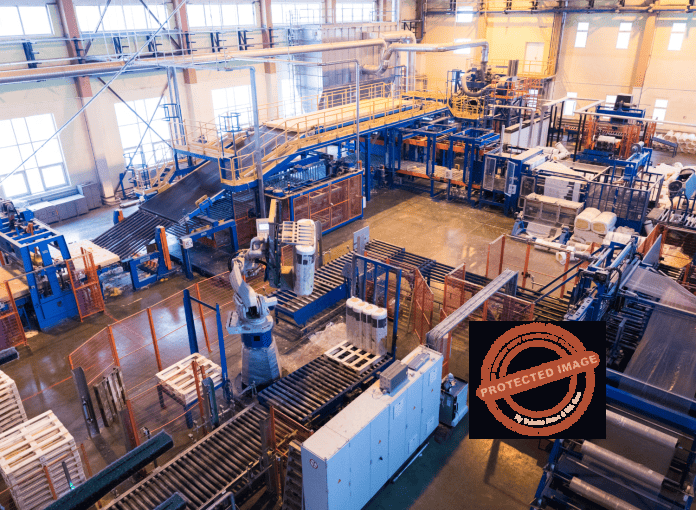What is manufacturing in business and why is it so important in the business world? If that question is on your mind and you want a great answer to it, then you are right where you need to be. Manufacturing is a common word. People use it regularly yet not a lot of people have a full understanding of what it is all about and how it influences the business world.
This is why this article has been written to educate you about this topic.
In this article, you will learn everything you need to know about manufacturing in business, from what it means down to the different types, its history, the steps involved in manufacturing, and so much more.
If you want to learn all of these things, then you have to read this article to the end.
Meaning of Manufacturing in Business – What is Manufacturing in Business
The word manufacturing is used to describe the process of turning raw materials into finished products using tools, machinery, chemical processing, and of course human labour.
A manufacturing business is a company that deals with manufacturing.
This kind of business buys and then processes raw materials into finished products.
They would then sell the finished goods at a higher value to make back the money they used in production and also realize their profit.
A big manufacturing company will typically run its manufacturing processes on a large scale.
This would allow the company to mass manufacture its products using advanced machinery and technologies.
Smaller companies may run on a smaller scale.
Regardless of whether manufacturing is done on a small or large scale, it has to be efficient for the company to generate profit.
By employing techniques that make the manufacturing process more efficient, a company can produce more goods at a reduced cost.
How Manufacturing Works – What is Manufacturing in Business
Manufacturing plays a huge role in our economy.
Without manufacturing, the world would not be anything like what we have today.
Manufacturing takes a material that isn’t that valuable or useful on its own and makes it into something valuable and useful.
For instance, a furniture manufacturing company would take wood and convert it into a table that would serve more purpose than if it were left as just wood.
The same goes for every other material used in other manufacturing sectors.
By processing these raw materials, manufacturing adds value to them.
This is why the price of the finished product will always be higher than the cost of the raw materials.
The price of the finished product also has to cover the costs of manufacturing the product and also generate profit for the company.
A company can reduce its manufacturing cost thereby increasing its profit margin by practicing efficient manufacturing techniques.
These include reducing redundancies, using up-to-date procedures and equipment, improving the quality of their work, and so on.
History of Manufacturing – What is Manufacturing in Business
The Industrial Revolution is what brought about the use of industrial processes that allowed companies to use raw materials to make a high volume of finished products.
Before this time, the market was mostly dominated by handmade products.
Industrial processes were possible because of the development of newer technologies like steam engines.
Companies started using these technologies to improve their manufacturing processes.
It allowed them to cut down the amount spent on human labour while increasing the volume of products that they could produce.
Assembly line processes and mass production made it possible for companies to make parts that they could use interchangeably.
This eliminated the need for customizing parts so making finished products became easier.
Mass production became even more popular in the early 20th century, chiefly because of Ford.
And there has been no going back ever since then.
Instead, newer and better technologies are being developed to improve the manufacturing industry.
There are now several electronic equipment and computer software that allow precision in manufacturing processes.
There are several high-tech methods and techniques in manufacturing today.
However, these are mostly used by large manufacturing companies because the capital investment for these technologies is quite high.
Operating these technologies also requires specialized labour.
So, the company has to pay more money for human labour.
This is why you would mostly find high-tech manufacturing companies in developed countries.
While most of the low-skill jobs have moved to developing countries; majorly because human labor in these economies is often less expensive.
Hand Manufacturing Vs Mass Manufacturing – What is Manufacturing in Business
Hand manufacturing used to be the only way of converting raw materials into finished products.
However, the Industrial Revolution brought mass manufacturing and changed the way products were manufactured.
This does not mean that hand manufacturing stopped existing.
On the contrary, it still exists in today’s world.
But hand manufacturing uses a lot of labour, basic tools, and traditional processes.
Today, you’d mostly hand manufacturing in decorative art, leatherwork, carpentry, textile production, and so on.
Handmade products consume a lot of time and labour.
This is why some handmade products are very expensive; depending on certain factors like the good type and the supplier.
For example, a limited handmade handbag can be more expensive than a mass-produced handbag.
However, sometimes, companies may exploit people who practice hand manufacturing.
They would employ these people and pay them salaries that do not match the labour they put into work.
This exploitation of handmade products often happens in places with lax labour laws and a high rate of unemployment.
Because of these reasons, people would rather take a low-paying job than stay idle.
Mass production on the other hand does not require a lot of human labor.
It relies heavily on machinery that increases efficiency and the production rate.
Types of Manufacturing – What is Manufacturing in Business
The following are some major types of manufacturing:
Advanced Manufacturing
Advanced manufacturing is all about using new technologies to improve production processes.
This type of manufacturing is very profitable because it allows companies to develop new products faster and introduce them to the market.
It allows the manufacturer to use raw materials to help meet the needs of their customers better.
It also helps increase a company’s output.
Additive Manufacturing
Most people just call this type of manufacturing 3D painting.
The production process here uses special equipment like 3D printers to build layers upon layers to create three-dimensional patterns and shapes.
For example, the medical sector uses additive manufacturing to produce high-variance items like dental implants.
The automotive industry also uses this manufacturing form.
They have advanced addictive techniques that make it possible for them to build some lightweight automobile parts.
Because of this, newer high-end vehicles can be lighter since they have strong carbon fibre parts.
Ultimately, this helps to improve the performance of these vehicles.
Additive manufacturing has several benefits such as reducing manufacturing time, helping companies make intricate designs, and reducing waste.
Contract Manufacturing
Contract manufacturing is quite common among manufacturers.
It involves partnering with another manufacturing company and then outsourcing some manufacturing processes to them.
For example, let’s say you run a food processing company.
Now, instead of producing your packaging yourself, you can outsource that particular manufacturing process to a company that manufactures packaging.
Or a company that manufactures cars can outsource the production of a part like the car windows and windshield to a 3rd party company.
Manufacturing Techniques – What is Manufacturing in Business
Different manufacturers use different techniques for their manufacturing process.
Typically, the type of technique the company employs is based on the industry and type of manufacturing business it runs.
The size of the business can also influence the technique it chooses to use.
Here are 3 major manufacturing techniques:
Made to Stock
Made-to-stock is the traditional manufacturing technique.
This technique involves forecasting demand rates and then making enough products to meet this demand.
This means that the manufacturer will estimate how many of its products it will sell in a particular period and then manufacture goods that match the estimation.
After making the goods, the company would then store them as inventory and wait for demand before they start distributing them.
For this technique to work, the company must carry out accurate forecasting.
They have to consider certain factors like customer expectations and other historical data.
Made-to-stock benefits companies because it makes it possible for them to use the economy of scales to their advantage.
Because they would be manufacturing in bulk, they can cut costs in areas like labour, costs of acquiring raw materials, and so on.
It will also help them make a better plan since they will cover all the manufacturing processes at a stretch.
However, if the demand does not match the forecast, then the company may experience loss because it will be stuck with its inventory.
The excess inventory will simply tie down the funds that the company could use for other things.
Made to Order
Made-to-order is the exact opposite of made-to-stock.
Here, a company waits for the customer to make their order (sign a contract) first before it begins manufacturing.
In this case, the product will be built as per the customer’s needs and specifications.
Most times, the manufacturer would first make a prototype and will only start manufacturing after the product’s full specification is agreed upon.
This technique is commonly used in the construction and aerospace industry; as well as, any industry that uses specialized products for specific purposes.
MTO products are not easily accessible in the market.
Therefore, these products are often very expensive and clients may have to pay a premium for the product.
MTO manufacturers hardly have inventory so they do not have to worry about not selling out.
However, this also means that the business may experience certain slow periods because of uneven demands.
Made to Assemble
This involves making parts of the products and then waiting for an order.
Once a customer makes an order, the manufacturer would then assemble the parts that they had earlier manufactured to complete the finished product.
Because all the manufacturer has to do once they get an order is to assemble the parts, they will deliver the products faster to the client than if they were using the made-to-order technique.
This technique is sort of a hybrid of made-to-order and made-to-stock.
And because of this, it comes with the disadvantages of both techniques.
It also means that the company that uses this technique may also lose the benefits that MTS and MTO offer.
The manufacturer would typically make the parts according to the data they get from forecasting demand.
Now, if they do not meet this demand, they will be stuck with the inventory.
Manufacturing Steps – What is Manufacturing in Business
There are different stages of the manufacturing process.
These stages go from when the product is all but an idea down to the stage where you’d have the finished product.
This section of this article will discuss these manufacturing steps in chronological order.
Idea Development
The first step in making any type of product is to conceive and develop the product idea.
At this stage, the manufacturer has to conceptualize the product.
They need to envision it and find out what it is exactly.
The manufacturer also needs to identify other important factors that will influence the product, like its target audience, the problem the product would solve, if there are already similar products in the market (competitors), and so on.
Considering these factors will help the manufacturer develop the product in their mind and decide on the characteristics that the product should have.
Market Research
Next, the manufacturer would have to conduct market research.
The process of manufacturing is not limited to the actual making of the product.
If the manufacturer fails to conduct market research, they may miss some important details that would have helped the product succeed.
A manufacturer’s market research would typically include finding out more about the raw materials, the equipment they need to manufacture the product, how to get a competitive edge, and so on.
Product Design
Now, the manufacturer has to design the product.
They would do this while considering the data from the market research.
They would consider the prospective customers’ needs.
Manufacturing cost is also an important factor that manufacturers consider at this point.
They do this to forecast the profitability of the business.
Research and development is the crux of this entire stage.
Making the Prototype
The next step would be to make a prototype of the product.
The manufacturer will make the prototype according to what they have done from step 1 up to this point.
At this stage, they would make major decisions about the product.
This includes deciding on the choice of raw materials and so on.
The prototype will replicate what the manufacturer expects the product to be at the end.
Testing the Prototype
When the manufacturer has the prototype, they will then test it.
This step goes beyond testing just the prototype.
The manufacturer would also use this step to determine if there is any inefficiency or limitation in their manufacturing process.
They would also analyze the prototype to figure out the cost of manufacturing and the value of the product.
The manufacturer should have a better projection of their profit margin at this point.
Manufacturing the Product
Once the prototype passes the test, mass production of the product will commence.
The company would get the necessary equipment and other resources it needs to commence operations.
These other resources would include human labour, storage, and so on.
Monitoring the Process – What is Manufacturing in Business
The company has to keep tabs on the product and its manufacturing line to ensure everything is working the way it should.
It must be sure that the product is meeting expectations.
And if it isn’t, the manufacturers have to reevaluate the product to make it better.
Even if the product is meeting expectations, the manufacturer still needs to monitor its production and evaluate it from time to time.
Production Vs Manufacturing – What is Manufacturing in Business
Production and manufacturing are two words people tend to use interchangeably.
However, while these two processes are similar, they have certain differences that would make using them interchangeably inaccurate.
Manufacturing is somewhat an aspect of production.
Production covers several processes including manufacturing.
While manufacturing is transforming raw materials into finished products, production covers any process that takes input and then yields output.
At the end of a manufacturing process, there would be a tangible product.
But with production, you could have either an intangible or a tangible product.
Another difference is that manufacturing relies heavily on machinery.
This is because it is all about adding value to raw materials.
This isn’t the case with production though.
Depending on what is being produced, a production process might or might not use machinery.
Also, a production company often owns the raw materials they work with.
Whereas, a manufacturing company has to get its raw materials from a third-party company or vendor.
Manufacturing Costs
Manufacturing costs refer to the amount of money a company spends in producing its products.
A company needs to calculate this cost because it is how it can properly value its product to get a decent profit margin.
Companies can also cut costs by calculating and analyzing their manufacturing costs.
A company will also be able to prevent loss if they are particular about this cost.
Manufacturing costs can either be direct or indirect.
Direct costs are expenses that are directly linked to a company’s manufacturing process.
These include expenses like labor, raw materials, consumables, costs of using their machinery, and so on.
Indirect costs on the other hand aren’t directly linked to the process of making the product.
These include things like utility bills, costs of repairing and maintaining machinery, rent, and so on.
A company can calculate its manufacturing cost by summing up its direct and indirect costs.
Conclusion on What is Manufacturing in Business
Manufacturing is the process of taking raw materials and adding more value to them to make them into finished products.
This process is very important in the business world because it is through it that companies make products that they sell to their customers.
If there were no manufacturing, a lot of things we have in the world today would not exist.
This is how this process is important in the business world and the world at large.









